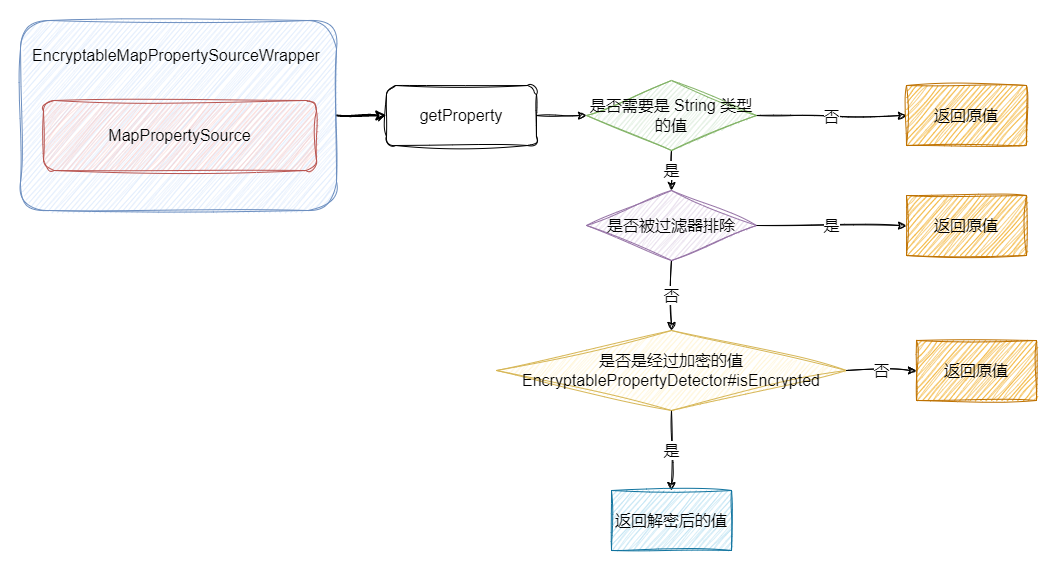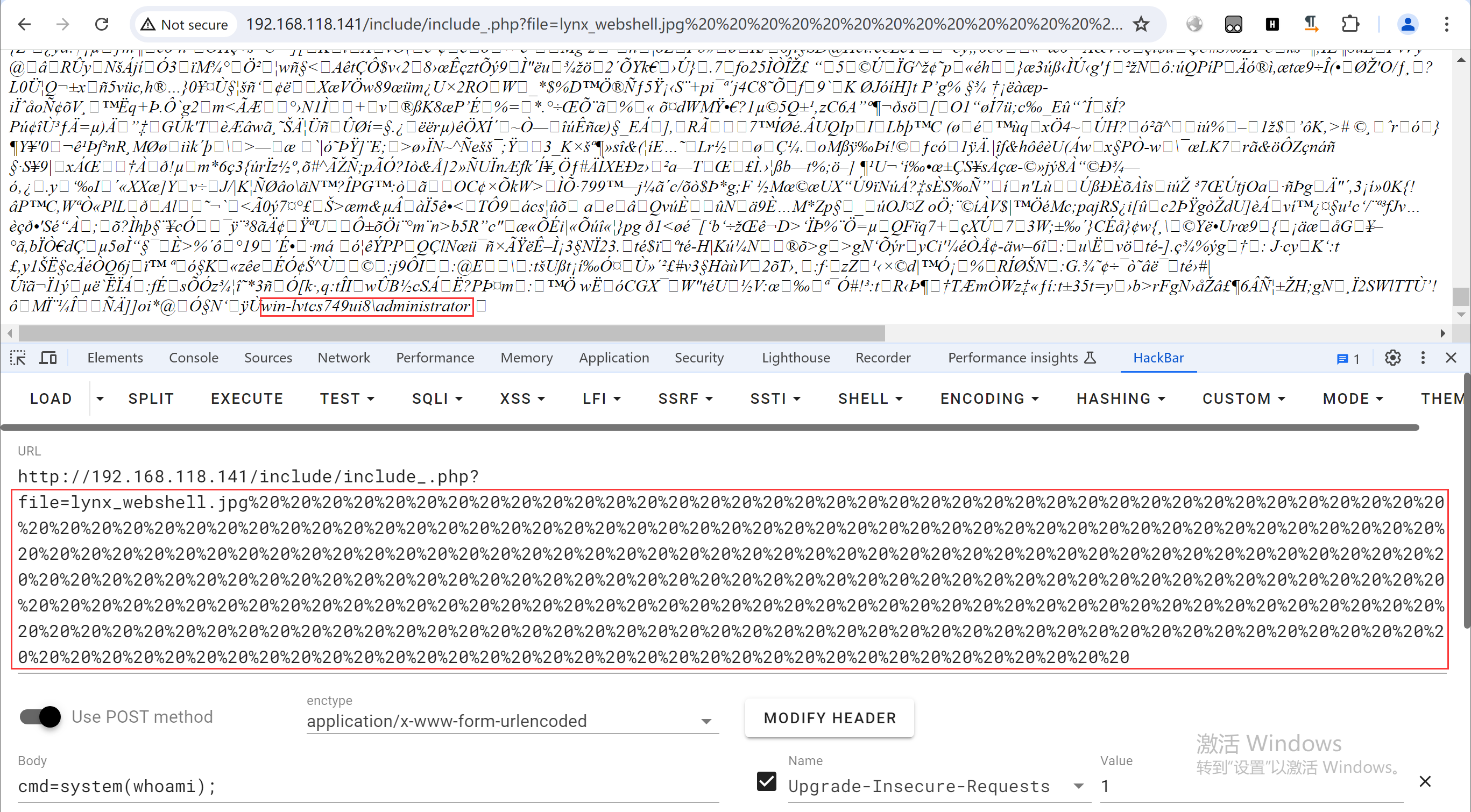前文
在某些场景下,使用 Spring 作为开发组件时,不可避免地需要使用到配置文件,然而,对于配置文件中的某些敏感数据(如密码等信息字段),如果使用明文的方式,则可能在一定程度上导致信息泄露。为此,需要一种有效的方式来对这些字段进行加密处理,当前主流的一种加密方式就是 Jasypt
基本使用
对于主流的 Spring 应用程序,现在基本上都是采用 Spring-Boot 的方式进行开发,因此我们可以很方便地以 starter 的方式引入 Jasypt 对应的 starter 依赖
<dependency><groupId>com.github.ulisesbocchio</groupId><artifactId>jasypt-spring-boot-starter</artifactId><version>3.0.5</version> <!-- 具体以 Maven 仓库的为准 -->
</dependency>
然后,需要在对应的应用程序配置文件中配置 Jasypt 的相关配置属性:
jasypt:encryptor:# 解密时需要用到的对称密码password: 1234567# 解密时使用的解密算法,具体可以查看 com.sun.crypto.provider.PBEKeyFactory 的相关子类algorithm: PBEWithHmacSHA224AndAES_128# 一些通用的配置属性,如过滤字段是否需要解密、需要解密的字段的格式等property:# 如果字段需要解密,则这个字段的值的开始前缀prefix: ENC(# 如果字段需要解密,则这个字段的值的后缀suffix: )# 加密时的重 Hash 次数key-obtention-iterations: 1000
然而,对于需要解密的字段,需要按照解密的规则对其进行加密处理,Jasypt 已经提供了现有的工具类,只需要传入我们需要的参数进行加密即可:
import org.jasypt.encryption.pbe.StandardPBEStringEncryptor;
import org.jasypt.encryption.pbe.config.EnvironmentStringPBEConfig;
import org.jasypt.iv.RandomIvGenerator;
import org.jasypt.salt.RandomSaltGenerator;
import org.junit.Test;
import org.slf4j.Logger;
import org.slf4j.LoggerFactory;
import org.springframework.boot.test.context.SpringBootTest;import javax.crypto.SecretKeyFactory;
import java.security.NoSuchAlgorithmException;
import java.security.Provider;
import java.security.Security;@SpringBootTest(classes = {DemoApplication.class})
public class SimpleEncryptTest {private final static Logger log = LoggerFactory.getLogger(SimpleEncryptTest.class);// 注意,这里的 Config 必须与上文配置文件中的一致,否则会导致解密结果与最初值不一致private static EnvironmentStringPBEConfig pbeConfig() {String password = "1234567"; // 这里的密码需要与配置文件里的相对应final EnvironmentStringPBEConfig config = new EnvironmentStringPBEConfig();config.setPassword(password); // 当前对称加密算法需要的基本密码,而不是需要转换的文本/*具体对称加密算法,目前系统提供了 com.sun.crypto.provider.PBEKeyFactory 子类相关的算法*/config.setAlgorithm("PBEWithHmacSHA224AndAES_128");/*迭代计算次数,通过增加这个值可以提高加密效果的强度*/config.setKeyObtentionIterations(1000); // 如果配置文件不做配置,则默认 1000 次config.setSaltGenerator(new RandomSaltGenerator()); // 具体的盐值生成器,未配置时默认使用 RandomSaltGenerator/*如果需要设置自定义的对称加密算法,那么这里可能需要设置成对应的算法提供对象,在一般情况下,系统提供的加密算法已经足够满足需求,因此可以设置为 null*/config.setProvider(null);config.setStringOutputType("Base64"); // 处理时的字节表示形式config.setIvGenerator(new RandomIvGenerator()); // 某些算法可能需要使用到的初始向量生成器,默认为 RandomIvGeneratorreturn config;}@Testpublic void encryptTest() {String message = "123"; // 当前需要被加密的密码final EnvironmentStringPBEConfig config = pbeConfig();final StandardPBEStringEncryptor encryptor = new StandardPBEStringEncryptor();encryptor.setConfig(config);log.info("{}", encryptor.encrypt(message)); // 这里得到的就是加密后的结果}
}
现在,将加密后的密码配置到我们系统的配置文件中,使用 jasypt 配置中定义的前后缀进行包装,以 Druid 配置为例,通过上文的加密算法,我将密码 "123" 加密后得到了 对应的加密文本 "354GiF5aGOgfrpisxVAw+y1fCNQ43Hv4vaHd9GVp8YZi86e0igV8sS6zyF1N14AP",现在将它配置到 Druid 的登录密码中:
spring:datasource:druid:stat-view-servlet:enabled: truelogin-username: adminlogin-password: ENC(354GiF5aGOgfrpisxVAw+y1fCNQ43Hv4vaHd9GVp8YZi86e0igV8sS6zyF1N14AP)
之后,如果希望登录 Druid 监视界面,只需要输入用户名为 admin 并且密码 123 即可完成登录
组件配置
一般情况下,Jasypt 默认的配置已经足够满足大部分的应用场景,然而,如果希望能够自定义相关的配置,Jasypt 也提供了相应的配置选项,主要包括 "过滤器"、"解码器" 以及 "检测器",这些组件在 com.ulisesbocchio.jasyptspringboot.properties.JasyptEncryptorConfigurationProperties.PropertyConfigurationProperties 有具体的描述
过滤器
过滤器的目的为了过滤那些需要进行解码的属性,默认情况下是对所有的配置属性都进行拦截处理,如果需要进行相关配置,可以在配置文件中加入相关的过滤属性字段:
jasypt:encryptor:property:filter:# 需要传入全限定名称,以过滤这些不需要解密的字段exclude-names: ["spring.datasource.druid.stat-view-servlet.login-password"]
显然,如果需要过滤的字段太多,一个一个配置比较麻烦,因此我们可以自定顶一个过滤器来完成相关的过滤操作,具体的实现以 com.ulisesbocchio.jasyptspringboot.EncryptablePropertyFilter 定义的为准:
import com.ulisesbocchio.jasyptspringboot.EncryptablePropertyFilter;
import com.ulisesbocchio.jasyptspringboot.properties.JasyptEncryptorConfigurationProperties;
import org.springframework.beans.factory.annotation.Autowired;
import org.springframework.core.env.ConfigurableEnvironment;
import org.springframework.core.env.PropertySource;
import org.springframework.stereotype.Component;import java.util.HashSet;
import java.util.Set;// 设置过滤器 Bean 名称,使得能够被加载到 Jasypt 的配置中
@Component("jasyptPropertiesFilter")
public class PropertiesFilterimplements EncryptablePropertyFilter {private final Set<String> excludeSet = new HashSet<>();@Autowiredpublic PropertiesFilter(ConfigurableEnvironment env) {// 复用 Jasypt 的过滤器配置属性JasyptEncryptorConfigurationProperties props = JasyptEncryptorConfigurationProperties.bindConfigProps(env);JasyptEncryptorConfigurationProperties.PropertyConfigurationProperties.FilterConfigurationProperties filterProps = props.getProperty().getFilter();excludeSet.addAll(filterProps.getExcludeNames());}@Overridepublic boolean shouldInclude(PropertySource<?> source, String name) {// 如果是开发环境,则不需要对字段进行加密处理if (source.getName().endsWith("dev.yml")) {return true;}// 如果前缀与配置的匹配,则不进行加密处理for (String excludeName : excludeSet) {if (excludeName.startsWith(name)) {return false;}}return true;}
}
同时,需要将编写好的过滤器替换到原有的过滤器,可以通过配置如下属性来完成:
jasypt:encryptor:property:filter:# 通过我们自定的过滤器,就不再需要写全限定名称了,只需要写对应的不匹配前缀即可exclude-names: ["spring.datasource.druid"]filter-bean: jasyptPropertiesFilter
检测器
检测器的目的是为了检查配置的属性是否是被加密的,效果与过滤器类似,区别在于过滤器的效果会先于检测器,默认的检测器实现是通过配置的前后缀值来进行判断的,即配置的 ENC()。如果希望改变这个行为(虽然基本不会改变 😦),也可以自定编写检测器来替换现有的行为,具体的实现需要以 com.ulisesbocchio.jasyptspringboot.EncryptablePropertyDetector 定位为准:
import com.ulisesbocchio.jasyptspringboot.EncryptablePropertyDetector;
import com.ulisesbocchio.jasyptspringboot.detector.DefaultPropertyDetector;
import org.apache.commons.codec.binary.Base64;
import org.springframework.stereotype.Component;@Component("jasyptPropertiesDetector")
public class PropertiesDetectorextends DefaultPropertyDetectorimplements EncryptablePropertyDetector {private String prefix = "ENC(";public PropertiesDetector() {super();}public PropertiesDetector(String prefix, String suffix) {super(prefix, suffix);this.prefix = prefix;}@Overridepublic boolean isEncrypted(String property) {if (super.isEncrypted(property)) {return true;}// 如果是以 Base64 的方式进行的编码,则我们认为它是被加密的return property.length() >= 64 && Base64.isBase64(property);}@Overridepublic String unwrapEncryptedValue(String property) {if (property.contains(prefix)) {return super.unwrapEncryptedValue(property);}return property;}
}
同样,需要将其配置到对应的配置文件中,替换默认的检测器使得其生效:
jasypt:encryptor:property:detector-bean: jasyptPropertiesDetector
解码器
解码器是真正完成解码工作的组件,如果希望配置一些额外的加密选项(如加盐、替换向量生成器,使用自定义的解密算法等),都可以通过重写该组件来完成。
具体的解码器需要按照 com.ulisesbocchio.jasyptspringboot.EncryptablePropertyResolver 来实现:
import com.ulisesbocchio.jasyptspringboot.EncryptablePropertyDetector;
import com.ulisesbocchio.jasyptspringboot.EncryptablePropertyResolver;
import com.ulisesbocchio.jasyptspringboot.exception.DecryptionException;
import com.ulisesbocchio.jasyptspringboot.properties.JasyptEncryptorConfigurationProperties;
import org.jasypt.encryption.pbe.PooledPBEStringEncryptor;
import org.jasypt.encryption.pbe.config.SimpleStringPBEConfig;
import org.jasypt.exceptions.EncryptionOperationNotPossibleException;
import org.jasypt.iv.StringFixedIvGenerator;
import org.jasypt.salt.StringFixedSaltGenerator;
import org.slf4j.Logger;
import org.slf4j.LoggerFactory;
import org.springframework.beans.factory.annotation.Autowired;
import org.springframework.beans.factory.annotation.Qualifier;
import org.springframework.core.env.ConfigurableEnvironment;
import org.springframework.core.env.Environment;
import org.springframework.stereotype.Component;import java.util.Optional;@Component("jasyptPropertiesPropertyResolver")
public class PropertiesPropertyResolverimplements EncryptablePropertyResolver {private final static Logger log = LoggerFactory.getLogger(PropertiesPropertyResolver.class);private final static String IV_GEN_TEXT = "这是一个向量生成器";private final static String SALT_TEXT = "我能够吞下玻璃而不伤身体";private final Environment environment;private final PooledPBEStringEncryptor encryptor;private final EncryptablePropertyDetector detector;@Autowiredpublic PropertiesPropertyResolver(ConfigurableEnvironment env,@Qualifier("jasyptPropertiesDetector") EncryptablePropertyDetector detector) {this.environment = env;this.encryptor = new PooledPBEStringEncryptor();this.detector = detector;// 复用原有 Jasypt 的配置属性JasyptEncryptorConfigurationProperties props = JasyptEncryptorConfigurationProperties.bindConfigProps(env);String password = props.getPassword();// 这里的配置将会覆盖原有配置文件中的相关配置,因为配置文件中的配置并不能显示地支持配置对象的设置SimpleStringPBEConfig config = new SimpleStringPBEConfig();config.setPasswordCharArray(password.toCharArray());config.setAlgorithm("PBEWITHHMACSHA512ANDAES_256");config.setKeyObtentionIterations("1000");config.setPoolSize(1);config.setProviderName("SunJCE");config.setSaltGenerator(new StringFixedSaltGenerator(SALT_TEXT)); // 替换默认的盐值生成器config.setIvGenerator(new StringFixedIvGenerator(IV_GEN_TEXT)); // 替换默认的向量生成器config.setStringOutputType("base64");this.encryptor.setConfig(config);}@Overridepublic String resolvePropertyValue(String value) {return Optional.ofNullable(value).map(environment::resolvePlaceholders).filter(detector::isEncrypted).map(resolvedValue -> {try {String unwrappedProperty = detector.unwrapEncryptedValue(resolvedValue.trim());String resolvedProperty = environment.resolvePlaceholders(unwrappedProperty);String decrypt = encryptor.decrypt(resolvedProperty);log.info("from {} to {}", resolvedProperty, decrypt);return decrypt;} catch (EncryptionOperationNotPossibleException e) {throw new DecryptionException("Unable to decrypt property: "+ value + " resolved to: " + resolvedValue + ". Decryption of Properties failed, make sure encryption/decryption " +"passwords match", e);}}).orElse(value);}
}
同样地,也需要在配置文件中进行配置以替换默认的解码器:
jasypt:encryptor:property:resolver-bean: jasyptPropertiesPropertyResolver
实现原理
一般来讲,在 SpringBoot 项目中引入 starter 来实现自动装配 功能,基本上都是通过加载 META/spring.factories 文件中的自动配置项来实现的,对于 Jassypt 的 starter 来讲,对应的 spring.factories 文件如下:
org.springframework.boot.autoconfigure.EnableAutoConfiguration=com.ulisesbocchio.jasyptspringbootstarter.JasyptSpringBootAutoConfigurationorg.springframework.cloud.bootstrap.BootstrapConfiguration=com.ulisesbocchio.jasyptspringbootstarter.JasyptSpringCloudBootstrapConfiguration
SpringBoot 的加载接口从 EnableAutoConfiguration 配置引入,对应的配置项为 com.ulisesbocchio.jasyptspringbootstarter.JasyptSpringBootAutoConfiguration:
import com.ulisesbocchio.jasyptspringboot.configuration.EnableEncryptablePropertiesConfiguration;import org.springframework.context.annotation.Configuration;
import org.springframework.context.annotation.Import;@Configuration
@Import(EnableEncryptablePropertiesConfiguration.class)
public class JasyptSpringBootAutoConfiguration {
}
实际上这个类并没有实际的配置操作,而是通过导入 EnableEncryptablePropertiesConfiguration 来间接实现的:
import com.ulisesbocchio.jasyptspringboot.EncryptablePropertySourceConverter;
import org.jasypt.encryption.StringEncryptor;
import org.jasypt.encryption.pbe.config.StringPBEConfig;
import org.springframework.beans.factory.config.BeanFactoryPostProcessor;
import org.springframework.context.annotation.Bean;
import org.springframework.context.annotation.Configuration;
import org.springframework.context.annotation.Import;
import org.springframework.core.env.ConfigurableEnvironment;
import org.springframework.core.env.Environment;
import org.springframework.core.env.PropertySource;@Configuration
/*EncryptablePropertyResolverConfiguration 这个配置类为上文的 "解码器" 等相关组件的配置类,也就是实际完成解码工作的组件类
*/
@Import({EncryptablePropertyResolverConfiguration.class, CachingConfiguration.class})
public class EnableEncryptablePropertiesConfiguration {@Beanpublic static EnableEncryptablePropertiesBeanFactoryPostProcessor enableEncryptablePropertySourcesPostProcessor(final ConfigurableEnvironment environment, EncryptablePropertySourceConverter converter) {return new EnableEncryptablePropertiesBeanFactoryPostProcessor(environment, converter);}
}
对于内置的 EnableEncryptablePropertiesBeanFactoryPostProcessor Bean,Spring 会在初始化 BeanFactory 时调用这些 BeanPostProcessor 的 postProcessBeanFactory 方法,以实现对 BeanFactory 的配置处理。具体 EnableEncryptablePropertiesBeanFactoryPostProcessor 的处理如下:
import com.ulisesbocchio.jasyptspringboot.EncryptablePropertyResolver;
import com.ulisesbocchio.jasyptspringboot.EncryptablePropertySourceConverter;
import lombok.extern.slf4j.Slf4j;
import org.springframework.beans.BeansException;
import org.springframework.beans.factory.config.BeanFactoryPostProcessor;
import org.springframework.beans.factory.config.ConfigurableListableBeanFactory;
import org.springframework.core.Ordered;
import org.springframework.core.env.ConfigurableEnvironment;
import org.springframework.core.env.MutablePropertySources;public class EnableEncryptablePropertiesBeanFactoryPostProcessor implements BeanFactoryPostProcessor, Ordered {private final ConfigurableEnvironment environment;private final EncryptablePropertySourceConverter converter;public EnableEncryptablePropertiesBeanFactoryPostProcessor(ConfigurableEnvironment environment, EncryptablePropertySourceConverter converter) {this.environment = environment;this.converter = converter;}@Overridepublic void postProcessBeanFactory(ConfigurableListableBeanFactory beanFactory) throws BeansException {log.info("Post-processing PropertySource instances");/*这里的作用是加载系统中存在的配置文件,包括系统自带的 System、BootStrap 以及 application 等配置文件*/MutablePropertySources propSources = environment.getPropertySources();/*替换原有的配置文件对象,以改变获取配置属性值的相关行为*/converter.convertPropertySources(propSources);}// 省略部分代码
}
关键的部分在于对 propSources 的替换处理,具体的源码如下:
public class EncryptablePropertySourceConverter {public void convertPropertySources(MutablePropertySources propSources) {propSources.stream().filter(ps -> !(ps instanceof EncryptablePropertySource)).map(this::makeEncryptable).collect(toList()).forEach(ps -> propSources.replace(ps.getName(), ps));}public <T> PropertySource<T> makeEncryptable(PropertySource<T> propertySource) {// 省略部分代码。。。。PropertySource<T> encryptablePropertySource = convertPropertySource(propertySource);return encryptablePropertySource;}private <T> PropertySource<T> convertPropertySource(PropertySource<T> propertySource) {// 默认不是代理模式,因此走 instantiatePropertySource 方法return interceptionMode == InterceptionMode.PROXY? proxyPropertySource(propertySource) : instantiatePropertySource(propertySource);}private <T> PropertySource<T> instantiatePropertySource(PropertySource<T> propertySource) {PropertySource<T> encryptablePropertySource;if (needsProxyAnyway(propertySource)) {encryptablePropertySource = proxyPropertySource(propertySource);} else if (propertySource instanceof SystemEnvironmentPropertySource) {encryptablePropertySource = (PropertySource<T>) new EncryptableSystemEnvironmentPropertySourceWrapper((SystemEnvironmentPropertySource) propertySource, propertyResolver, propertyFilter);} else if (propertySource instanceof MapPropertySource) {/*应用程序的配置文件对应的类型为 MapPropertySource,因此走这里,即:将原有应用程序配置文件对应的属性配置对象替换成了 EncryptableMapPropertySourceWrapper 类型*/encryptablePropertySource = (PropertySource<T>) new EncryptableMapPropertySourceWrapper((MapPropertySource) propertySource, propertyResolver, propertyFilter);} else if (propertySource instanceof EnumerablePropertySource) {encryptablePropertySource = new EncryptableEnumerablePropertySourceWrapper<>((EnumerablePropertySource) propertySource, propertyResolver, propertyFilter);} else {encryptablePropertySource = new EncryptablePropertySourceWrapper<>(propertySource, propertyResolver, propertyFilter);}return encryptablePropertySource;}
}
继续查看 EncryptableMapPropertySourceWrapper对应的源码:
import com.ulisesbocchio.jasyptspringboot.caching.CachingDelegateEncryptablePropertySource;
import com.ulisesbocchio.jasyptspringboot.EncryptablePropertyFilter;
import com.ulisesbocchio.jasyptspringboot.EncryptablePropertyResolver;
import com.ulisesbocchio.jasyptspringboot.EncryptablePropertySource;
import org.springframework.boot.origin.Origin;
import org.springframework.boot.origin.OriginLookup;
import org.springframework.boot.origin.OriginTrackedValue;
import org.springframework.core.env.MapPropertySource;
import org.springframework.core.env.PropertySource;import java.util.Map;public class EncryptableMapPropertySourceWrapper extends MapPropertySource implements EncryptablePropertySource<Map<String, Object>> {private final CachingDelegateEncryptablePropertySource<Map<String, Object>> encryptableDelegate;public EncryptableMapPropertySourceWrapper(MapPropertySource delegate, EncryptablePropertyResolver resolver, EncryptablePropertyFilter filter) {super(delegate.getName(), delegate.getSource());encryptableDelegate = new CachingDelegateEncryptablePropertySource<>(delegate, resolver, filter);}/*重点在于对于获取属性时的特殊处理,具体是由 CachingDelegateEncryptablePropertySource 完成的实际处理*/@Overridepublic Object getProperty(String name) {return encryptableDelegate.getProperty(name);}@Overridepublic PropertySource<Map<String, Object>> getDelegate() {return encryptableDelegate;}
}
继续查看 CachingDelegateEncryptablePropertySource :
import com.ulisesbocchio.jasyptspringboot.EncryptablePropertyFilter;
import com.ulisesbocchio.jasyptspringboot.EncryptablePropertyResolver;
import com.ulisesbocchio.jasyptspringboot.EncryptablePropertySource;import java.util.Map;
import java.util.Objects;
import java.util.concurrent.ConcurrentHashMap;import lombok.AllArgsConstructor;
import org.springframework.core.env.PropertySource;
import org.springframework.util.Assert;public class CachingDelegateEncryptablePropertySource<T> extends PropertySource<T> implements EncryptablePropertySource<T> {private final PropertySource<T> delegate; // 原有的配置属性对象private final EncryptablePropertyResolver resolver; // 解码器private final EncryptablePropertyFilter filter; // 过滤器private final Map<String, CachedValue> cache; // 缓存,不重要public CachingDelegateEncryptablePropertySource(PropertySource<T> delegate, EncryptablePropertyResolver resolver, EncryptablePropertyFilter filter) {super(delegate.getName(), delegate.getSource());Assert.notNull(delegate, "PropertySource delegate cannot be null");Assert.notNull(resolver, "EncryptablePropertyResolver cannot be null");Assert.notNull(filter, "EncryptablePropertyFilter cannot be null");this.delegate = delegate;this.resolver = resolver;this.filter = filter;this.cache = new ConcurrentHashMap<>();}// 省略部分源码。。。。@Overridepublic Object getProperty(String name) {Object originValue = delegate.getProperty(name);if (!(originValue instanceof String)) {/*由于实际的解码器只能支持对 String 类型的解码,因此如果不是 String 类型的值则不做处理*/return originValue;}// 省略缓存的有关处理// 如果该字段不在过滤器的排除选项中,则进一步考虑解密的处理if (filter.shouldInclude(delegate, name)) {String originStringValue = (String) originValue;/*解码器的实际解码处理,至此,完成了对加密字段的解密获取处理*/String resolved = resolver.resolvePropertyValue(originStringValue);// 省略缓存的有关处理return resolved;}return originValue;}// 省略部分源码。。。。
}
具体结构图如下所示:












